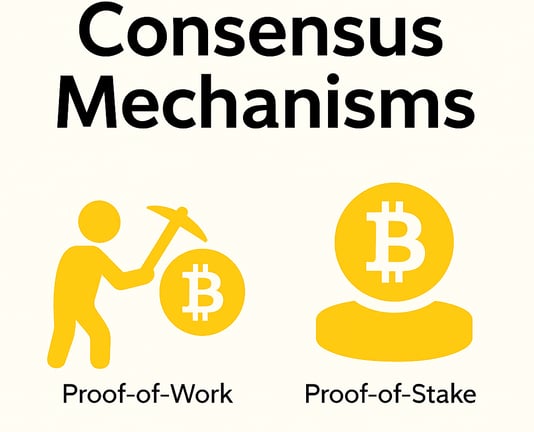How Blockchains Keep Their Promises: Understanding Consensus Mechanisms
This post breaks down one of the most important — but least understood — parts of blockchain: consensus mechanisms. It explains how decentralized networks like Bitcoin and Ethereum agree on what’s true without relying on banks or governments. From Proof-of-Work to Proof-of-Stake, readers will learn how these systems shape everything from speed and security to decentralization and power dynamics. Whether you're new to crypto or brushing up on fundamentals, this guide helps you ask the right questions before trusting any blockchain.
Jacob, DACC State Representative - Arizona
5/2/20252 min read


When most people think of blockchain, they picture Bitcoin. But behind every coin or token is a much deeper innovation: a system that lets thousands of strangers agree on what’s true — with no middleman, no bank, and no government.
This isn’t magic. It’s called a consensus mechanism, and it’s the foundation of every blockchain.
What Is a Blockchain?
Think of a blockchain as a digital notebook. Every few minutes, someone adds a new page with a list of transactions. Once a page is filled, it’s locked in and linked to the one before it — forming a “chain” of information that can’t be changed without everyone noticing.
But there’s no one person in charge of the notebook. It’s copied across thousands of computers around the world. So how do they all stay in sync?
That’s where consensus comes in.
How Blockchain Networks Agree
Blockchains need a system to agree on which transactions are valid and who gets to add the next page to the chain. These systems are called consensus mechanisms.
There are many versions, but two of the most common are:
Proof-of-Work (PoW)
Used by Bitcoin, this method has computers race to solve complex puzzles. The first one to solve it adds the next block and earns a reward. It’s extremely secure, but uses a lot of energy.
Proof-of-Stake (PoS)
Instead of solving puzzles, participants “stake” their coins to earn the right to validate blocks. The more you stake, the more influence you have. It’s faster and more energy-efficient, but changes the power structure of the network.
For more context, check out these explainers:
What Is Blockchain – Whiteboard Crypto (8 min): Watch
Consensus Mechanisms – Whiteboard Crypto (10 min): Watch
PoW vs. PoS – Coin Bureau (25 min): Watch
Why It Matters
Consensus mechanisms shape who has influence in a blockchain, how fast it runs, how secure it is, and how decentralized it really becomes.
Some blockchains allow anyone to become a validator — sometimes referred to as “minute man validators” or local validators. Others restrict participation to “trusted validators,” which introduces forms of centralization. There are trade-offs in every design.
Consensus is ultimately a question of access and trust — and how much of each you’re willing to give up.
Final Thoughts
Before you buy into any blockchain project, ask yourself: How does this network reach consensus? Who gets a say? What are the rules?
Because blockchains don’t just run on code. They run on the agreements that hold them together.
General Resources
Coin Bureau
https://www.youtube.com/@CoinBureau
Weekly news, deep dives, and educational breakdowns.
Digital Asset News
https://www.youtube.com/@DigitalAssetNews
Crypto current events and Q&A.
Whiteboard Crypto
https://www.youtube.com/@WhiteboardCrypto
Simple, short explainers on blockchain concepts.
